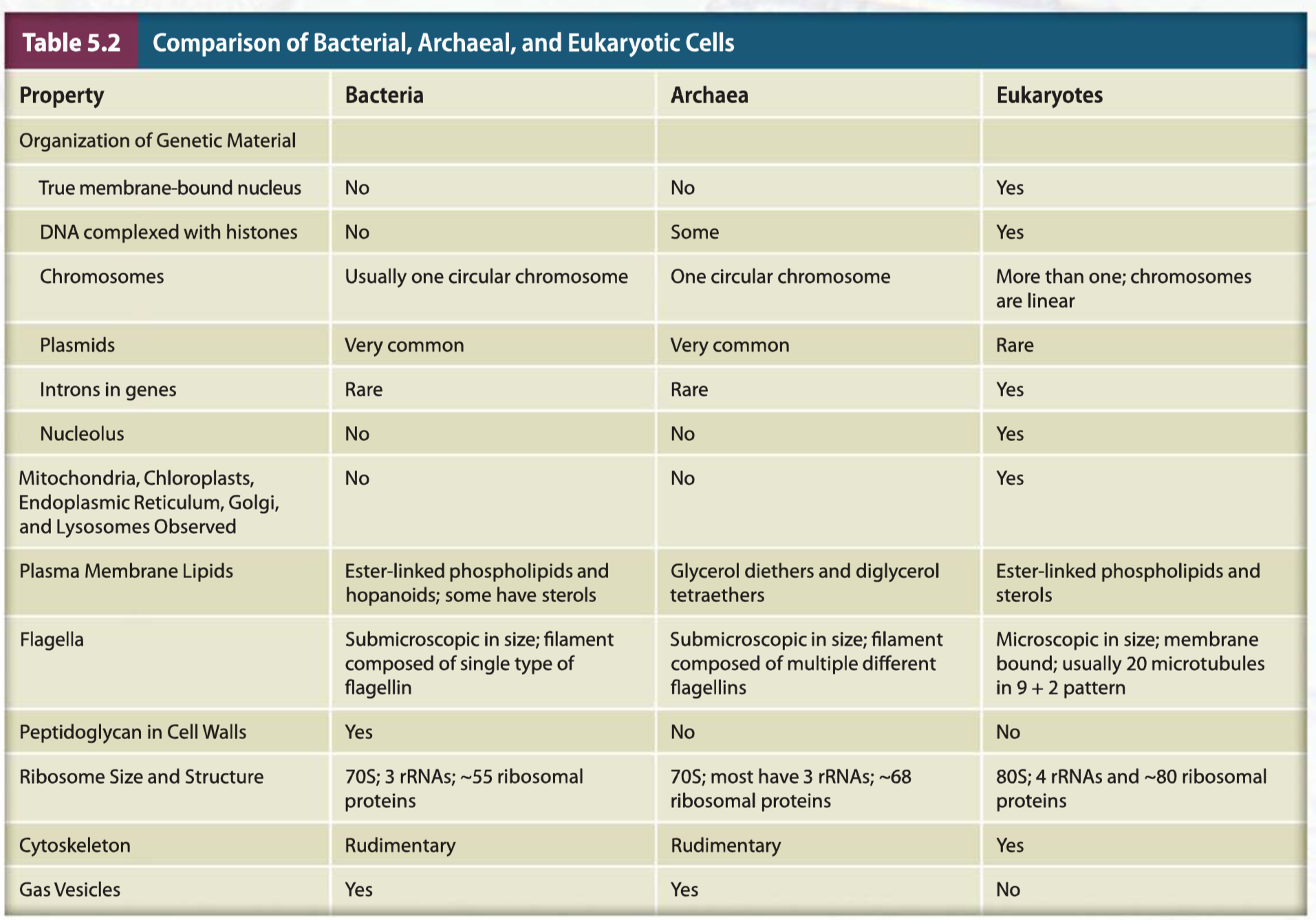L05 Eukaryotic Cell Structure
一、Typical Eukaryotic Cell
Eukaryotic Microorganisms
Two groups of eukaryotes commonly possess microbial members
protists
fungi
In general, eukaryotic cells are larger than bacterial and archaeal cells.
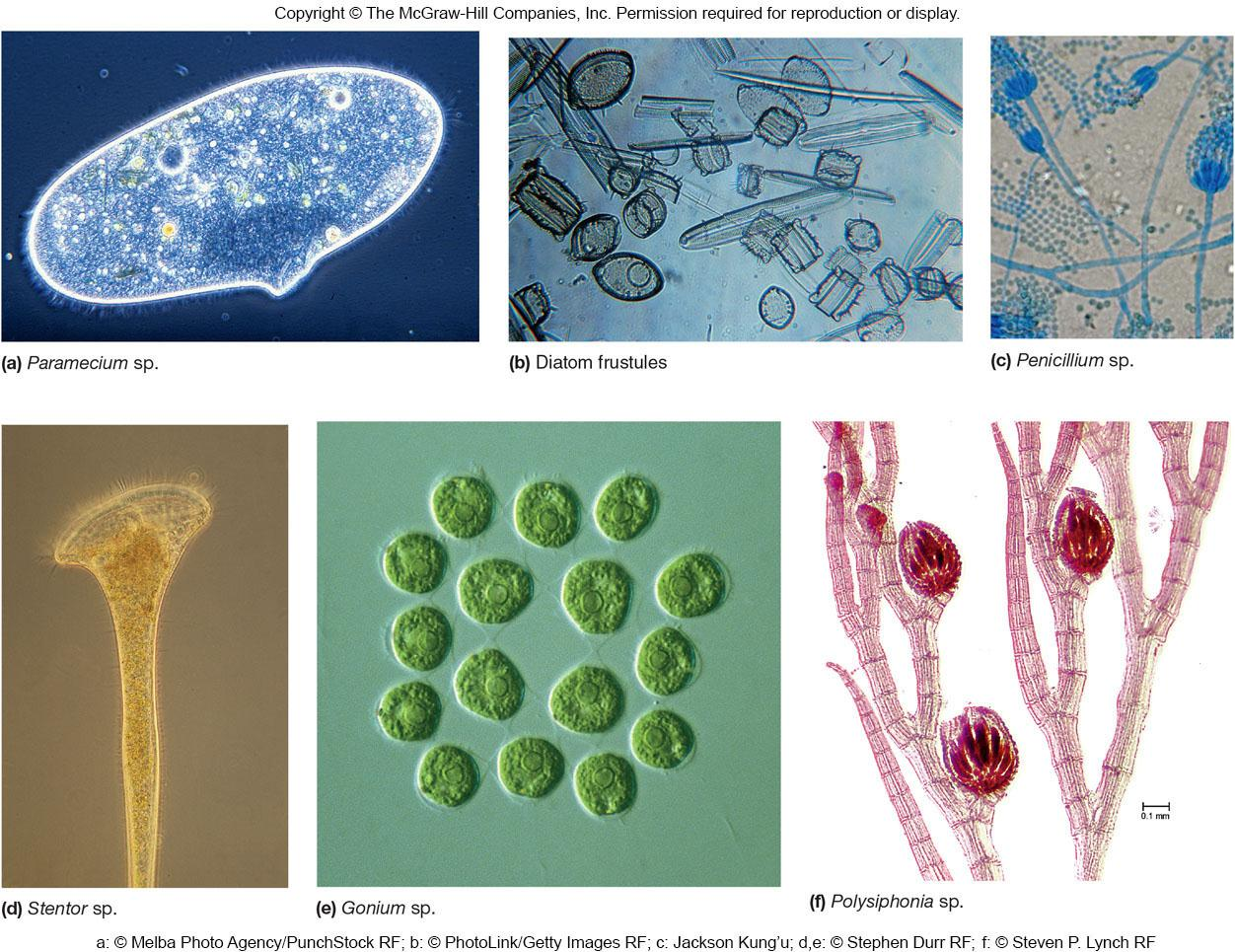
Common Features
Membrane-delimited nuclei
Membrane-bound organelles that perform specific functions
Intracytoplasmic membrane complex serves as transport system
More structurally complex and generally larger than bacterial or archaeal cells
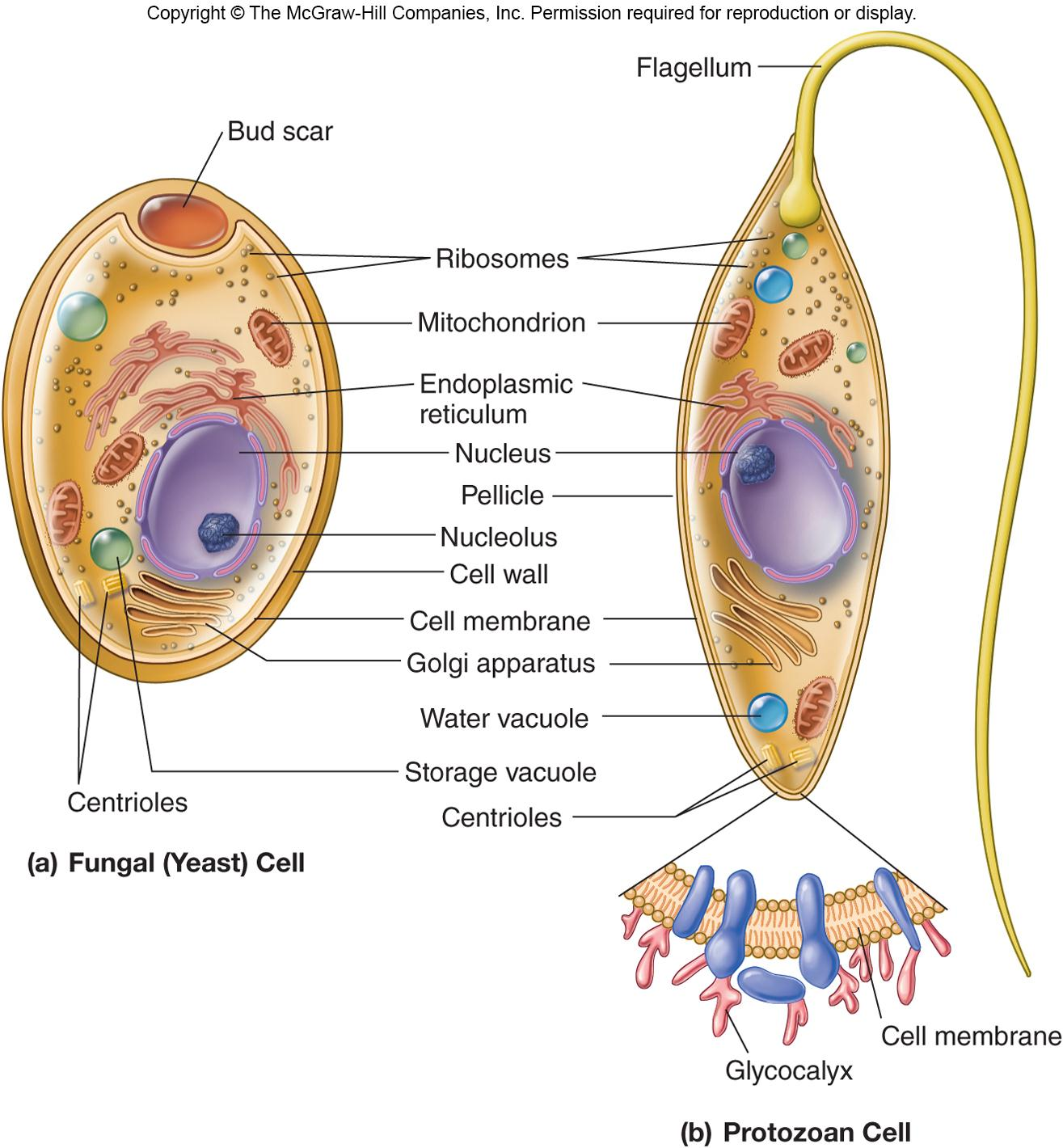
Organelles(细胞器) are intracellular structures that perform specific functions in cells analogous to the functions of organs in the body of a multicellular organism.
The partitioning(分割) of the eukaryotic cell interior by membranes makes possible the place ment of different cellular functions in separate compartments so that they can more easily take place simultaneously under independent control and proper coordination.
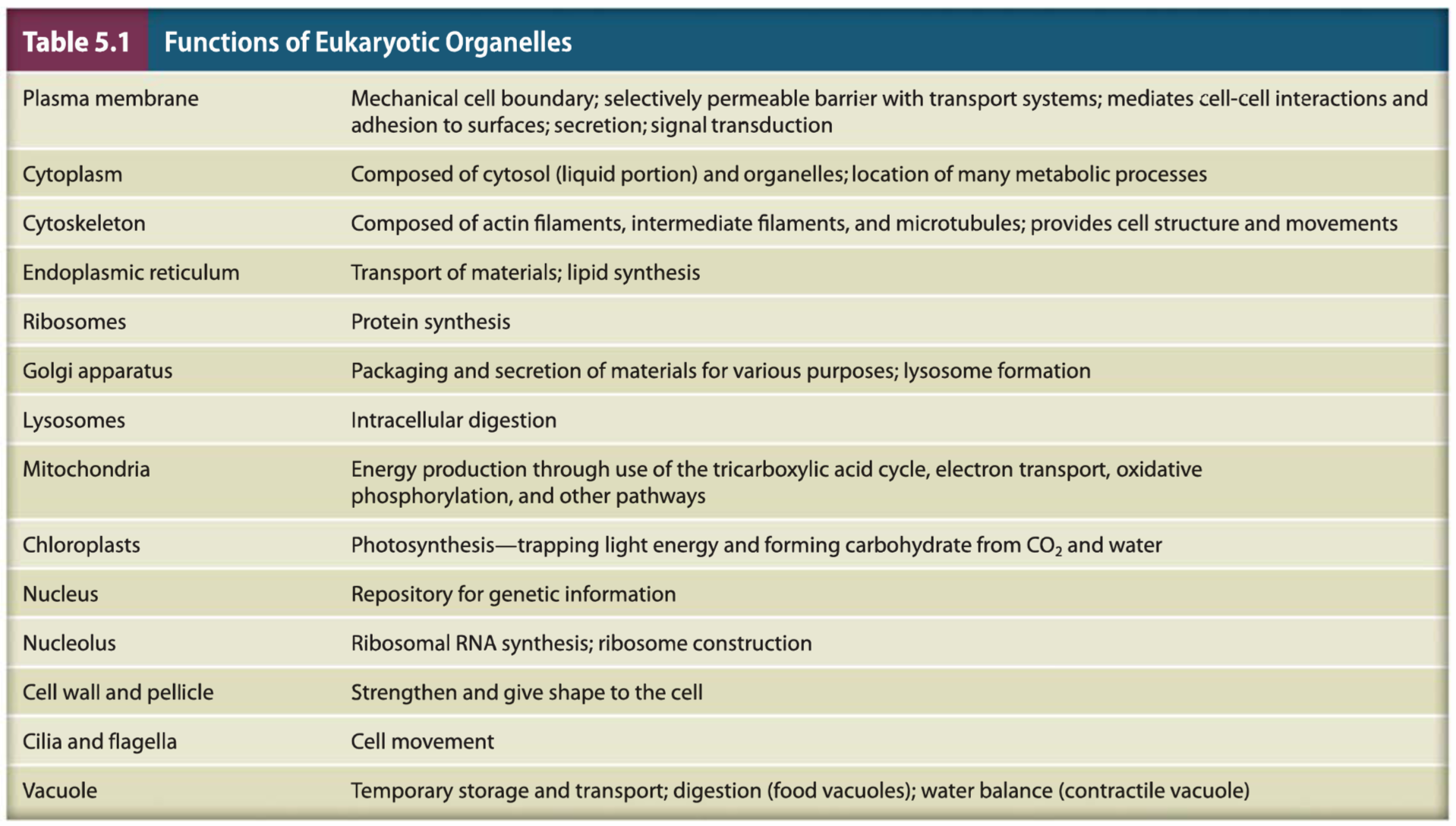
| Organelle | Functions |
|---|---|
| Plasma membrane | Mechanical cell boundary; selectively permeable barrier with transport systems; mediates cell-cell interactions and adhesion to surfaces; secretion; signal transduction |
| Cytoplasm | Composed of cytosol (liquid portion) and organelles; location of many metabolic processes |
| Cytoskeleton | Composed of actin filaments, intermediate filaments, and microtubules; provides cell structure and movements |
| Endoplasmic reticulum | Transport of materials; lipid synthesis |
| Ribosomes | Protein synthesis |
| Golgi apparatus | Packaging and secretion of materials for various purposes; lysosome formation |
| Lysosomes 溶酶体 | Intracellular digestion |
| Mitochondria | Energy production through use of the tricarboxylic acid cyde, electron transport, oxidative phosphorylation, and other pathways |
| Chloroplasts | Photosynthesis—trapping light energy and forming carbohydrate from CO2 and water |
| Nucleus 细胞核 | Repository for genetic information |
| Nucleolus 核仁 | Ribosomal RNA synthesis; ribosome construction |
| Cell wall and pellicle 细胞壁和防护膜 | Strengthen and give shape to the cell |
| Cilia and flagella 纤毛和鞭毛 | Cell movement |
| Vacuole | Temporary storage and transport; digestion (food vacuoles); water balance (contractile vacuole) |
二、Eukaryotic Cell Envelopes
The cell envelope consists of the plasma membrane and all coverings external to it
Plasma Membrane
The plasma membrane of eukaryotes is a lipid bilayer composed of a high proportion of sphingolipids(鞘脂) and sterols(固醇) (e.g., cholesterol and ergosterol) in addition to the phospholipids observed in bacterial membranes,同样具有磷脂
major membrane lipids include phosphoglycerides (甘油磷脂 ), sphingolipids (鞘脂), and cholesterol (胆固醇), all of which contribute to strength of membrane
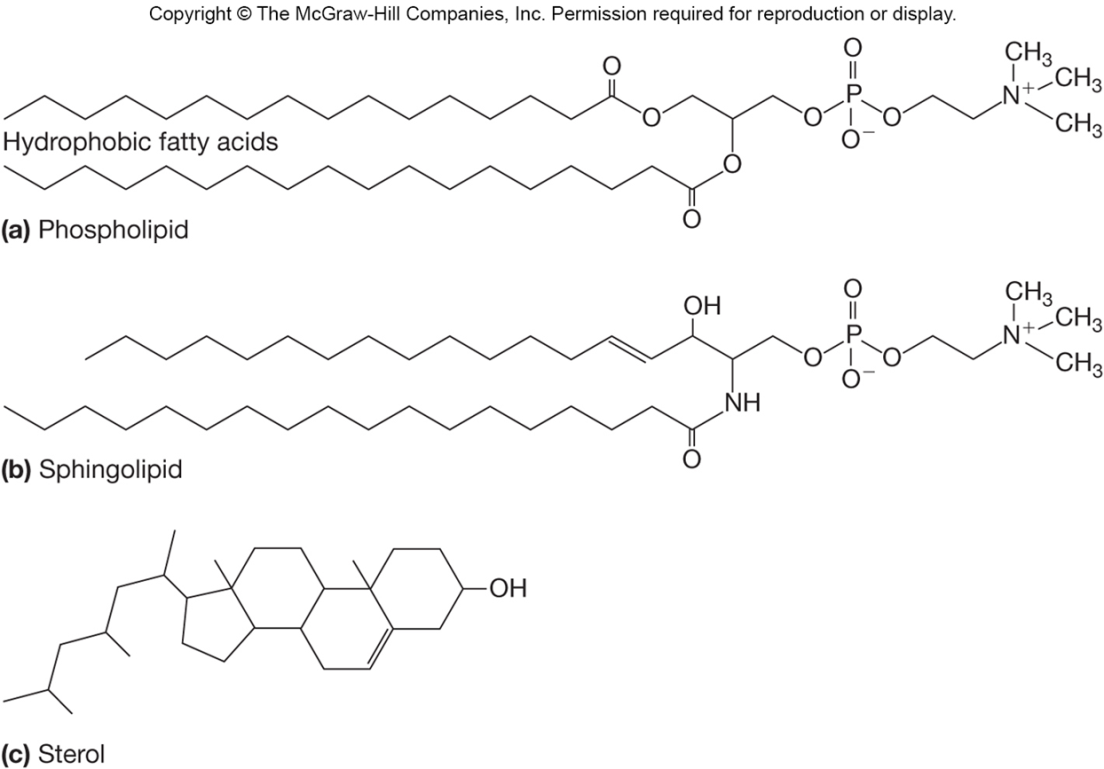
In both lipids, the fatty acids are attached to glycerol with ester links. The large amounts of sphingolipids and sterols contribute to the strength of the plasma membrane; they are able to pack together very closely, more so than phospholipids can.
This explains, in part, why so many eukaryotic microbes are able to resist osmotic pressure and other mechanical stresses even though they lack cell walls.
真核细胞膜表面的脂质分布并不是均匀的,在外膜与内膜的分布情况不同。
Although most lipids in each leaflet mix freely with each other, there are microdomains that differ in lipid and protein composition. These microdomains are sometimes referred to as lipid rafts. They have been implicated in a variety of cellular Hydrophobic fatty acids (a) Phospholipid processes (e.g., signal transduction, assembly and release of virus particles, and endocytosis).
Cell Wall
Unlike the peptidoglycan in the cell wall of Bacteria and Archaea, many eukaryotes lack
or have a chemically distinct cell wall
Cell walls of photosynthetic algae have cellulose, pectin, and silica
Cell walls of fungi consist of cellulose, chitin, or glucan
1. photosynthetic protists (commonly called algae)
They have a layered appearance and contain large quantities of polysaccharides(多糖) such as cellulose(纤维素) and pectin(果胶)
In addition, inorganic substances such as silica (in diatoms) or calcium carbonate may be present
Cell walls of photosynthetic algae consists of
2. Fungal cell
三、Cytoplasm
cytoskeleton
Cytoskeleton
filaments that form the cytoskeleton: actin, microtubule, and intermediate filament
plays role in both cell shape and cell movement
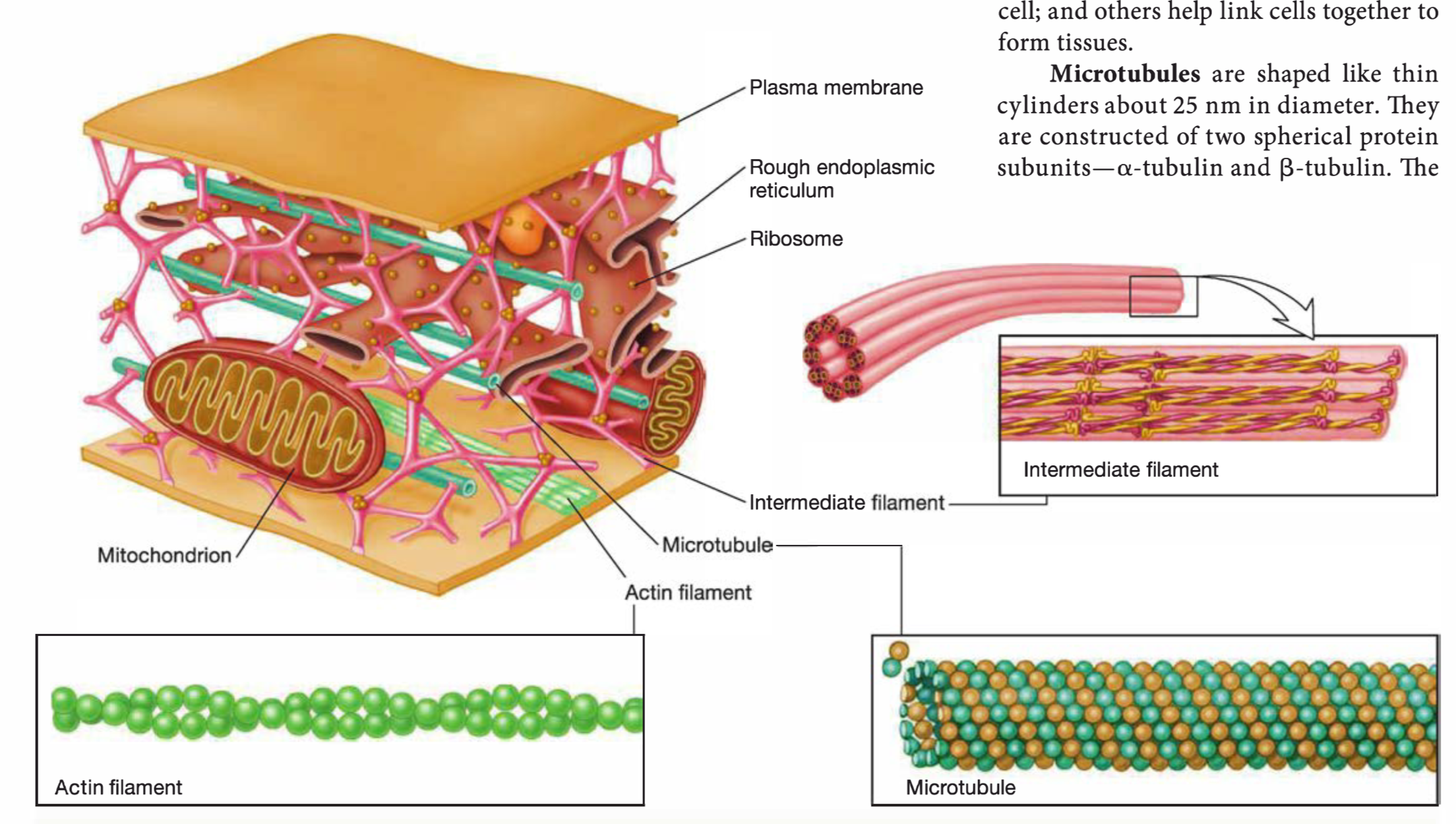
1. Actin filaments 肌动蛋白丝
Actin filaments are minute protein filaments, 4 to 7 nm in diameter, that are organized to form a variety of structures depending on the cell type
They are composed of an actin protein that is similar to the actin contractile protein of muscle tissue.
Actin filaments are involved in amoeboid movement, endocytosis, cytokinesis, and the movement of some structures within the cell.
2. Intermediate filaments 中间纤维
Intermediate filaments are heterogeneous(多种多样的) elements of the cytoskeleton that play structural roles. They are about 10 nm in diameter and are assembled from a group of proteins that can be divided into several classes (e.g., keratin and vimentin).
3. Microtubules 微管
Microtubules are shaped like thin cylinders about 25 nm in diameter. They are constructed of two spherical protein subunits:$\alpha$-tubulin and $\beta$ -tubulin($\alpha / \beta $ 微管蛋白)
The two proteins are the same molecular weight and differ only slightly in terms of their amino acid sequence and tertiary structure.
Microtubules form the spindle apparatus that separates chromosomes during mitosis and meiosis. They form tracks along which numerous types of organelles and vesicles are moved about the cell, and they are found in cilia and flagella, two organelles that confer motility
Microtubules also are found in cell structures requiring support such as long, slender, rigid pseudopodia(伪足) (called axopodia) observed in some protists
四、Organelles of Eukaryotes
Organelles of the Secretory and Endocytic Pathways
Intricate complex of membranous organelles and vesicles that move materials into the cell from outside, from inside to outside, and within the cell
Endoplasmic reticulum (ER)
Golgi apparatus
Lysosomes
1. Endoplasmic Reticulum
The endoplasmic reticulum (ER) is an irregular network of branching and fusing membranous tubules, around 40 to 70 nm in diameter, and many flattened sacs called cisternae(潴泡) (s., cisterna).
rough endoplasmic reticulum (RER)
In cells synthesizing a great deal of protein to be secreted, a large part of the ER is studded on its outer surface with ribosomes and is called rough endoplasmic reticulum (RER).
smooth endoplasmic reticulum (SER).
Other cells, such as those producing large quantities of lipids, have ER that lacks ribosomes. This is smooth endoplasmic reticulum (SER).
2. Golgi Apparatus
A stack of cisternae has two faces that are quite different from one another. The sacs on the cis or forming face are closest to the ER and often associated with it.
The Golgi apparatus packages materials and prepares them for secretion, the exact nature of its role varying with the organism.
The golgi apparatus has two faces.
3. Lysosomes
Lysosomes are found in animal cells. They are roughly spherical, are enclosed in a single membrane, and average about 500 nm in diameter but range from 50 nm to several $\mu$m in size
They are involved in intracellular digestion and contain the enzymes needed to digest all types of macromolecules.
Lysosome-like organelles are found in fungal and protist cells, where they are usually called vacuoles, phagocytic vacuoles, or food vacuoles.
Secretory Pathway
1. Proteins
Proteins destined for the plasma membrane, structures of the endocytic pathway , or secretion are synthesized by ribosomes attached to the rough endoplasmic reticulum (RER).
Vesicles released from the ER travel to the cis face of the Golgi https://20190531-1259353497.cos.ap-guangzhou.myqcloud.com/atus (the side closest to the ER).

These proteins have sequences of amino acids that target them to the lumen of the RER through which they move until released in small vesicles that bud from the ER.
Transport vesicles are released from the trans face of the Golgi and deliver their contents to various locations in the cell.
2. Vesicles
Two types of vesicles transport materials to the plasma membrane.:
- One type constitutively delivers proteins in an unregulated manner, releasing them to the outside of the cell as the transport vesicle fuses with the plasma membrane.
- Other vesicles, called secretory vesicles, are found only in multicellular eukaryotes, where they are observed in secretory cells such as mast cells and other cells of the immune system. Secretory vesicles store the proteins to be released until the cell receives an appropriate signal. Once received, the secretory vesicles move to the plasma membrane, fuse with it, and release their contents to the cell exterior
神经递质?
3. quality-assurance mechanism
Proteins that fail to fold or have misfolded are not transported to their intended destination.
Endocytic Pathway
During endocytosis, a cell takes up solutes (pinocytosis,胞饮) or particles (phagocytosis,胞吞) by enclosing them in vesicles pinched off from the plasma membrane
1. Phagocytosis
Phagocytosis involves the use of protrusions from the cell surface to surround and engulf particulates. The endo cytic vesicles formed by phagocytosis are called phagosomes. Clathrin-dependent(网格蛋白依赖) endocytosis begins with coated pits, which are specialized membrane regions coated on the cytoplasmic side with the protein clathrin
Organelles Involved in Genetic Control of the Cell
- Nucleus
- Ribosomes
1. nuclear envelope
a complex structure consisting of inner and outer membranes separated by a perinuclear(核周的) space.
The nuclear envelope is contin uous with the ER at several points, and its outer membrane is covered with ribosomes.
A network of intermediate filaments, called the nuclear lamina, is observed in animal cells. It lies against the inner surface of the nuclear envelope and supports it.
Many nuclear pores penetrate the envelope, and each pore is formed by about 30 proteins; each pore plus the associated proteins is called a nuclear pore complex
2. nucleolus
A nucleus may contain from one to many nucleoli
Although the nucleolus is not membrane-enclosed, it is a complex organelle with separate granular and fibrillar regions.
The nucleolus plays a major role in ribosome synthesis. The DNA of the nucleolar organizer directs the production of ribosomal RNA (rRNA).
3. Eukaryotic Ribosomes
Eukaryotic ribosomes (i.e., those not found in mitochondria and chloroplasts) are larger than bacterial and archaeal 70S ribosomes.
Each ribosome is a dimer of a 60S and a 40S subunit. The 60S subunit is composed of three rRNA molecules {SS,
28S, and 5.8S rRNAs) and about 50 proteins.
The 40S subunit is composed of an 18S rRNA and about 30 proteins.
Organelles Involved in Energy Conservation
- Mitochondria
- Chloroplasts
- Hydrogenosomes 氢化酶体;氢化酶颗粒
1. Mitochondria
The mitochondrion is bounded by two membranes: an outer mitochondrial membrane separated from an inner mitochondrial membrane by a 6 to 8 nm intermembrane space
The outer mitochondrial membrane contains porins(孔蛋白) and thus is similar to the outer membrane of Gram-negative bacteria. The inner membrane has infoldings called cristae(嵴) (s., crista), which greatly increase its surface area.
In many organisms, mitochondrial DNA is a closed circle, like most bacterial DNA. However, in some protists, mitochondrial DNA is linear
Each mitochondrial compartment has a characteristic chemical and enzymatic composition. For example, the outer and inner mitochondrial membranes possess different lipids. Enzymes and electron carriers involved in electron transport and oxidative phosphorylation (the formation of ATP during respiration) are located only in the inner membrane. Enzymes of the tricarboxylic acid cycle and those involved with the catabolism (breaking down) of fatty acids are located in the matrix.
The mitochondrion uses its DNA and ribosomes to synthesize some of its own proteins. In fact, mutations in mitochondrial DNA often lead to serious diseases in humans.
most mitochondrial proteins are manufactured under the direction of the nucleus and must be transported into the mitochondrion.
Mitochondria reproduce by binary fission, a reproductive process used by many bacteria.
2. Chloroplasts
Chloroplasts are quite variable in size and shape.
A matrix called the stroma is enclosed by the inner membrane. The stroma contains DNA, ribosomes, lipid droplets, starch granules, and a complex internal membrane system whose most prominent components are flattened, membrane delimited sacs called thylakoids(类囊体).
In some photosynthetic protists, several disk-like thylakoids are stacked on each other like coins to form grana (s., granum).
The trapping of light energy to generate ATP, NADPH, and O2 is referred to as the light reactions. These reactions are located in the thylakoid membranes, where chlorophyll and electron transport components are also found.
The dark reactions take place in the stroma.
3. Hydrogenosomes
Small energy conservation organelles in some anaerobic protists
Descended from common mitochondrial ancestor
double membrane, no cristae, usually lack DNA
ATP is generated by fermentation process rather than respiration
CO2 , H2 , and acetate(醋酸盐) are products
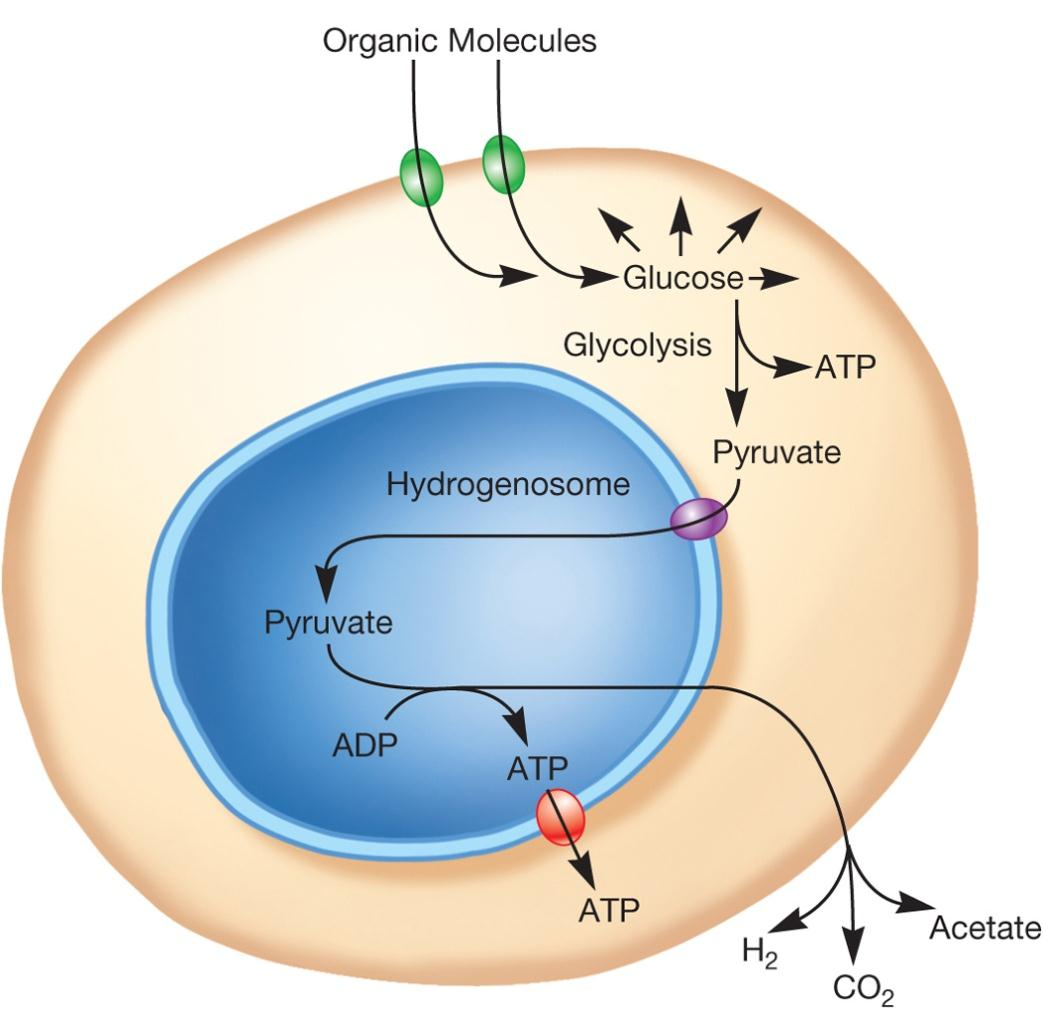
Hydrogenosomes are small organelles involved in energy-conservation processes in some anaerobic(厌氧的) protists
Like mitochondria, hydrogenosomes are bound by a double membrane. However, they often lack cristae and usually lack DNA.
五、External Structures
Cilia
Flagella
Cilia And Flagella
Flagella (s., flagellum)
- 100-200 pm long
- move in undulating (波动;起伏) fashion
Cilia (s., cilium)
5-20 pm long
beat with two phases,
working like oars
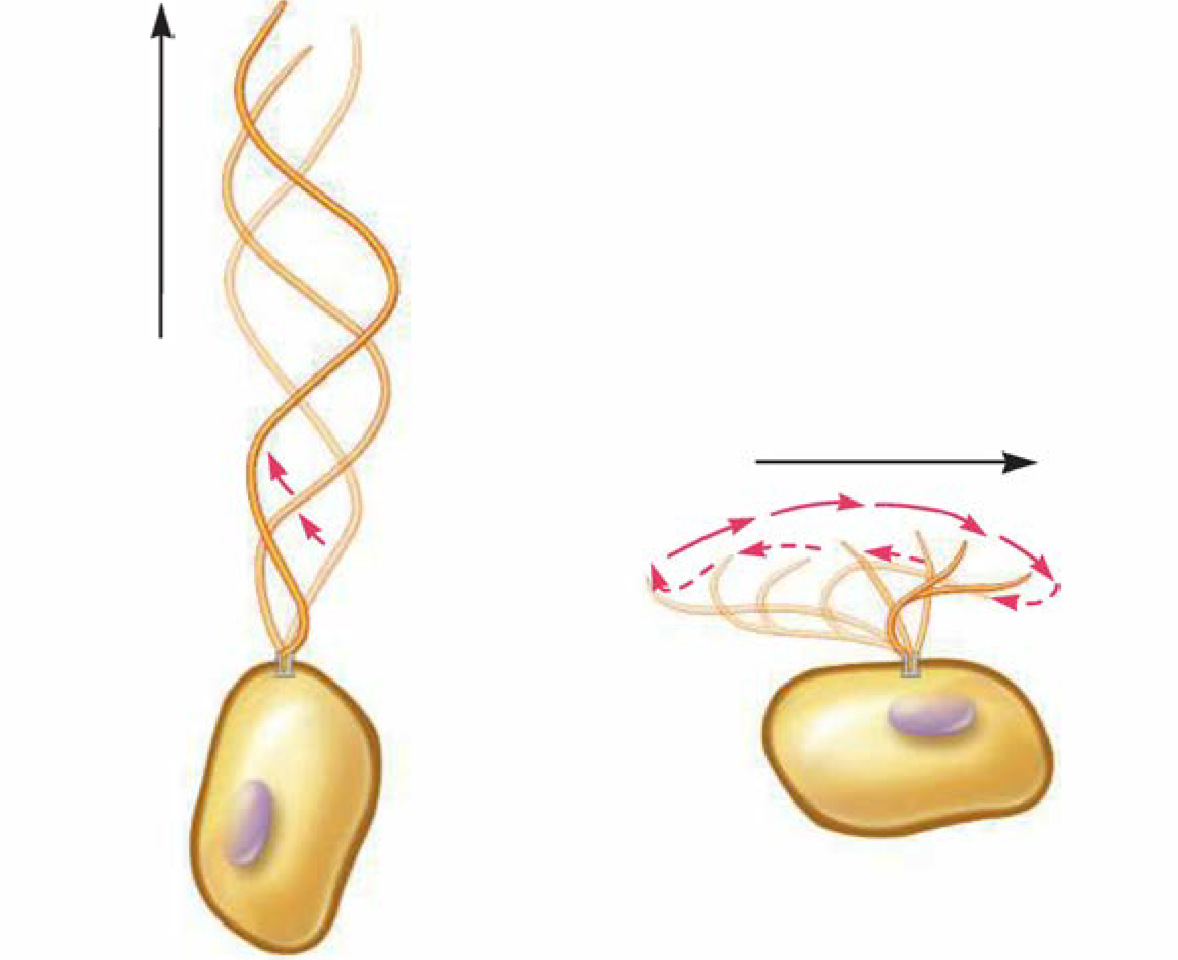
Cilia (s., cilium,纤毛) and flagella (s., flagellum,鞭毛) are the most prominent external structures observed on eukaryotic cells; they are associated with motility.
Flagella is 100-200 μm long and move in undulating(波动) fashion.
Cilia is 5-20 μm long and beat two phases, working like oars(桨).
Some flagella have lateral hairs called flimmer filaments (thicker, stiffer hairs are called mastigonemes). These
filaments change flagellar action so that a wave moving down the filament toward the tip pulls the cell along instead of pushing it.
Such flagella often are called tinsel flagella, whereas naked flagella to as whiplash flagella
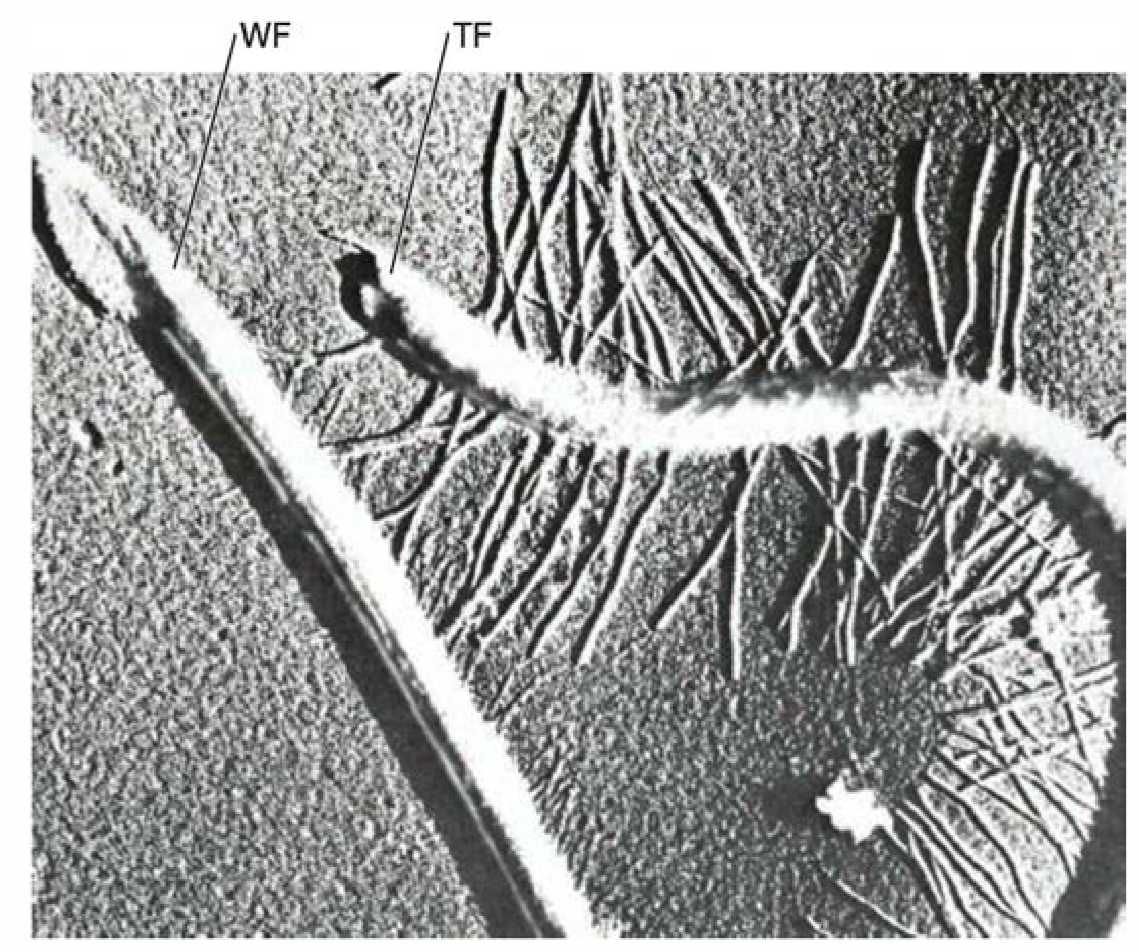
A ciliated microorganism actually coordinates the beats so that some of its cilia are in the recovery phase while others are carrying out their effective stroke
This coordination(协调) allows the organism to move smoothly through the water.
Structure
Membrane-bound cylinders ~0.2 μm in diameter
Axoneme: set of microtubules in a 9+2 arrangement
Basal body
at base of flagellum or cilium
directs synthesis of flagella and cilia
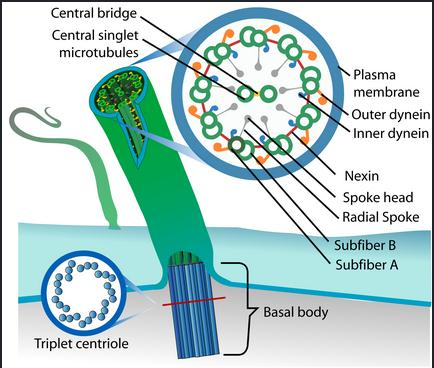
在细菌与古菌中,flagella不由膜包被,而在整合细胞中,flagella是具膜结构。
Despite their differences, cilia and flagella are very similar in ultrastructure(超微结构).
They are membrane-bound cylinders about 0.2 $\mu$m in diameter. Located in the matrix of the organelle is the axoneme, which usually consists of nine microtubule doublets arranged in a around two central microtubules
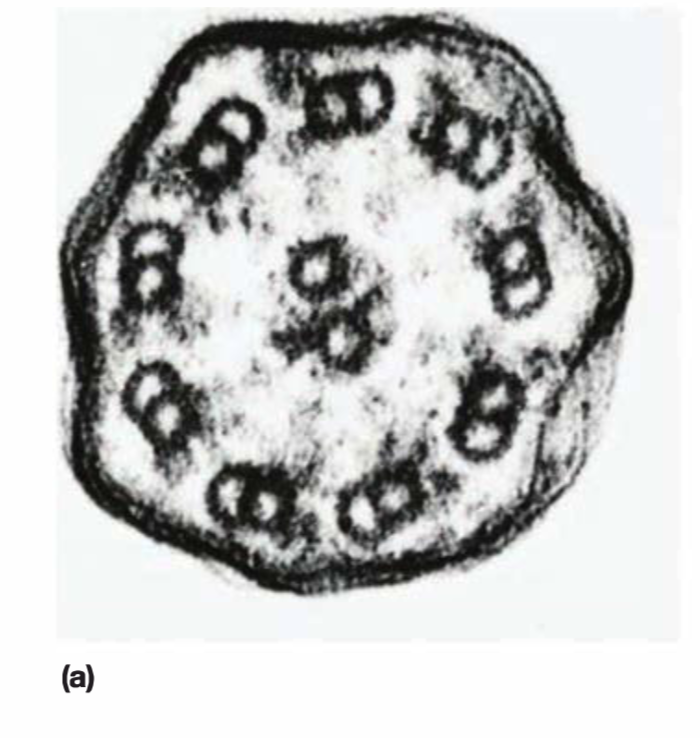
**Axoneme: **set of microtubules in 9+2 arrangement.(其中两个在中间,周围排列9个.)
Basal body:
–at base of flagellum or cilium
–directs synthesis of flagella and cilia
六、Comparison
Molecular unity basic to all three cells
genetic code
biochemical processes, metabolic pathways
Differences in eukaryotic cells
eukaryotic nucleus
larger, more complex
meiosis, mitosis
complex processes
